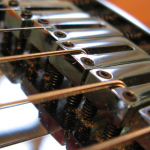Buzz-Kill – Tracking Down A Zingy String
 There are a number of reasons that a plucked guitar string might buzz. We’ll probably go into some of those reasons in future articles but, as I happened to have one of the more uncommon reasons for a buzzing string in the workshop, I thought I’d share it with you.
There are a number of reasons that a plucked guitar string might buzz. We’ll probably go into some of those reasons in future articles but, as I happened to have one of the more uncommon reasons for a buzzing string in the workshop, I thought I’d share it with you.
What I had was a Tele with a few minor issues and a pronounced, ‘zingy’, buzz on the D-string. This wasn’t fret-buzz – the string buzzed even when fingered at the last fret with no more neck in the picture (and dampened behind to make sure the section of string between my finger and the nut wasn’t buzzing which is an occasional issue). Also, the timbre of the buzz was a little unusual. As I said, it was zingy, metallic, almost like a sitar.
The culprit didn’t take too long to track down. It was the saddle.
This Tele was manufactured with six cast and chromed saddles. The strings install from the rear of the guitar (through-body stringing), through a hole in the bridge and bear over the saddle before continuing up the neck. This is normally fine and problem free. In this case however, the saddle under the D-string was not the same as the others.
 Normally, there is smooth, curved ramp up the back of one of these saddles which ‘crests’ and then, slightly, ‘ramps off’ again down the front. In this way, the string only contacts with a tiny portion – essentially the top of a curved ramp. In this case, the ramp didn’t curve back down the front. It just stopped 3 or 4mm from the front of the saddle, leaving that 4mm of flat surface for the string to travel over. The tiny clearance between string and this flat surface was enough that the vibrating string contacted with the saddle with a metallic zing. For all intents and purposes, this was emulating a sitar.
Normally, there is smooth, curved ramp up the back of one of these saddles which ‘crests’ and then, slightly, ‘ramps off’ again down the front. In this way, the string only contacts with a tiny portion – essentially the top of a curved ramp. In this case, the ramp didn’t curve back down the front. It just stopped 3 or 4mm from the front of the saddle, leaving that 4mm of flat surface for the string to travel over. The tiny clearance between string and this flat surface was enough that the vibrating string contacted with the saddle with a metallic zing. For all intents and purposes, this was emulating a sitar.
It’s a little (but only a little) easier to see in the photographs. Click the images for bigger versions. The first image (above left) shows the tensioned strings bearing over the saddles. I’ve circled the wound D and you can see the G-string next door for a view of what it should be like. The second image (right) shows the saddle with the string loosened and the expanse of flat saddle is clear.
If the action had been higher, it’s likely that the string would have pressed more firmly against the flat section and not buzzed. As it was, it gave a pretty clear zingy, ringy, buzz.
The solution isn’t difficult but it is a pain. It will be necessary to either replace the saddle or to remove it and modify the string channel by careful grinding, filing and polishing. Refitting the saddle and resetting the intonation should kill this particular buzz.
Incidentally, the A-string saddle on this guitar has a similar, if less pronounced issue. It’s not actually causing a problem at the moment but I’ll probably take care of both at the same time.

